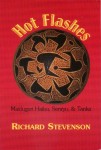 |
HOT FLASHES: Maiduguri Haiku, Senryu, & Tanka
by Richard Stevenson
Ekstasis Editions, 2001
Reviewed by Ted Harms
Before publishing HOT FLASHES: Maiduguri Haiku,
Senryu, & Tanka, Richard Stevenson had already published three collections based upon
the two years he taught in Nigeria. Then these poems came over him in '...moments of red hot prickly heat...' (hence
the title) but, with almost 20 years between the experience and writing them
down, he says there's a little more detachment with these poems than those
previous. Nonetheless, many poems still vibrate with an immediacy that is
well suited to the short poetry form that Stevenson has chosen.
Writing poetry about
Africa in an age-old Oriental form makes for an interesting cultural
intersection. Haiku, senryu, and tankas are all
relatively strict forms of poetry. The form of haiku and senryu and are
both traditionally 3 lines of 5, 7, and 5 'onji' (which is the Japanese
equivalent, but not really all that close, to our syllables) while tanka
stretches out a bit more and is 5 lines of 5, 7, 5, 7, and 7 syllables.
Further, and depending on who you listen to, there are inherent subject
matters that accompany each form - traditionally, all three forms need to
refer to or make an allusion to the weather, either in allegory or metaphor.
Modern practitioners are split on how accurate about these guidelines they
feel they need to be.
Given the shortness of these forms, these are not poems that allow an
author to slowly build up to a climax, set the stage or establish the mood.
This is not to say that these forms can't give you pause or reveal hidden
meanings with re-readings - it's that the author has be very careful and
deliberate about words and rhythms as they won't get a second chance.
Some of his poems are wonderful for their brevity and pure description:
resting his shovel,
the gardener drops his pants
and shits on the lawn
While others are more evocative and provide a lasting image:
their "pink teacher" -
how her golden arm hairs glisten!
wheat in winter sun
But, as is the risk when you don't have the chance to build up the scene or
give some background, sometimes the poem wobbles a bit because the reader
has to chew too much to get its drift:
pin-striped alhaji
slipping into a neem's shade?
no, a blue-tailed skink.
With a collection like this, it's unfair to nit-pick at individual poems and
you need to give Stevenson the odd mulligan where you don't 'get' one. The
observations Stevenson makes of what was his everyday life are clear and
vivid. Other than the odd bit of Nigerian vernacular, there's not much to
criticize in Stevenson's excellent collection - it's written very well,
reads very well, and the reader is uncovers more with each re-read.
Ted Harms is a philosopher who lives in Waterloo, Ontario. |
| |
TDR is produced in Toronto, Ontario, Canada.
All content is copyright of the person who
created it and cannot be copied, printed, or downloaded without the consent of
that person.
See the masthead
for editorial information.
All views expressed are those of the writer
only.
TDR is archived with the Library
and Archives Canada.
ISSN 1494-6114.
Facebook
page
|